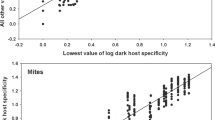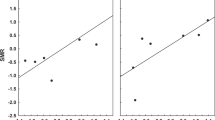Abstract
Population density is a fundamental property of a species and yet it varies among populations of the same species. The variation comes from the interplay between intrinsic features of a species that tend to produce repeatable density values across all populations of the same species and extrinsic environmental factors that differ among localities and thus tend to produce spatial variation in density. Is inter-population variation in density too large for density to be considered a true species character? We addressed this question using data on abundance (number of parasites per individual host, i.e. equivalent to density) of fleas ectoparasitic on small mammals. The data included samples of 548 flea populations, representing 145 flea species and obtained from 48 different geographical regions. Abundances of the same flea species on the same host species, but in different regions, were more similar to each other than expected by chance, and varied significantly among flea species, with 46% of the variation among samples accounted by differences between flea species. Thus, estimates of abundance are repeatable within the same flea species. The same repeatability was also observed, but to a lesser extent, across flea genera, tribes and subfamilies. Independently of the identity of the flea species, abundance values recorded on the same host species, or in the same geographical region, also showed significant statistical repeatability, though not nearly as strong as that associated with abundance values from the same flea species. There were also no strong indications that regional differences in abiotic variables were an important determinant of variation in abundance of a given flea species on a given host species. Abundance thus appears to be a true species trait in fleas, although it varies somewhat within bounds set by species-specific life history traits.


Similar content being viewed by others
References
Anderson RM, May RM (1978) Regulation and stability of host–parasite population interactions. I. Regulatory processes. J Anim Ecol 47:219–247
Arneberg P, Skorping A, Read AF (1997) Is population density a species character? Comparative analyses of the nematode parasites of mammals. Oikos 80:289–300
Arneberg P, Skorping A, Grenfell B, Read AF (1998) Host densities as determinants of abundance in parasite communities. Proc R Soc Lond B 265:1283–1289
Begon M, Townsend CR, Harper JL (2005) Ecology: from individuals to ecosystems, 4th edn. Blackwell Publishing, London
Beissinger SR, Westphal MI (1998) On the use of demographic models of population viability in endangered species management. J Wildl Manag 62:821–841
Blackburn TM, Gaston KJ (2001) Linking patterns in macroecology. J Anim Ecol 70:338–352
Dean SR, Meola RW (1997) Effect of juvenile hormone and juvenile hormone mimics on sperm transfer from the testes of the male cat flea (Siphonaptera: Pulicidae). J Med Entomol 34:485–488
Dogiel VA, Petrushevski GK, Polyanski YI (1961) Parasitology of fishes. Oliver & Boyd, Edinburgh
Fieberg J, Ellner SP (2000) When is it meaningful to estimate an extinction probability? Ecology 81:2040–2047
Galaktionov KV (1996) Life cycles and distribution of seabird helminths in Arctic and subarctic regions. Bull Scand Soc Parasitol 6:31–49
Gaston KJ, Blackburn TM (2003) Dispersal and the interspecific abundance–occupancy relationship in British birds. Glob Ecol Biogeogr 12:373–379
Grenfell BT, Dobson AP (eds) (1995) Ecology of infectious diseases in natural populations. Cambridge University Press, Cambridge
Hsu MH, Wu WJ (2000) Effects of multiple mating on females reproductive output in the cat flea (Siphonaptera: Pulicidae). J Med Entomol 37:828–834
Hsu MH, Hsu TC, Wu WJ (2002) Distribution of cat fleas (Siphonaptera: Pulicidae) on the cat. J Med Entomol 39:685–688
Hughes TP, Baird AH, Dinsdale EA, Moltschaniwskyj NA, Pratchett MS, Tanner JE, Willis BL (2000) Supply-side ecology works both ways: the link between benthic adults, fecundity, and larval recruits. Ecology 81:2241–2249
Ioff IG (1941) Ecology of fleas in relevance to their medical importance. Ordzhonikidze Regional Publisher, Piatigorsk (in Russian)
Iqbal QJ, Humphries DA (1974) The mating behaviour of the rat flea Nosopsyllus fasciatus Bosc. Pak J Zool 8:39–41
Kineman JJ, Hastings DA, Ohrenschall MA, Colby J, Schoolcraft DC, Klaus J, Knight J, Krager L, Hayes P, Oloughlin K, Dunbar P, Ikleman J, Anderson C, Burland J, Dietz J, Fisher H, Hannaughan A, Kelly M, Boyle S, Callaghan M, Delamana S, Di L, Gomolski K, Green D, Hochberg S, Holquist W, Johnson G, Lewis L, Locher A, Mealey A, Middleton L, Mellon D, Nigro L, Panskowitz J, Racey S, Roake B, Ross J, Row L, Schacter J, Weschler P (eds) (2000) Global ecosystems database version II: database, user’s guide, and dataset documentation. US Department of Commerce, National Oceanic and Atmospheric Administration, National Geophysical Data Center. http://www.ngdc.noaa.gov/seg/eco/cdroms/gedii_a/go.htm
Klein SL, Nelson RJ (1998) Adaptive immune responses are linked to the mating system of arvicoline rodents. Am Nat 151:59–67
Kosminskyi RB (1965) Feeding and reproduction of fleas of house mice under natural and experimental conditions. Zool Zh 44:1372–1375 (in Russian)
Krampitz HE (1980) Host preference, sessility and mating behaviour of Leptopsylla segnis reared in captivity. In: Traub R, Starcke H (eds) Fleas. Proceedings of the international conference on fleas, Ashton Wold, Peterbotough, UK, 21–25 June 1977. A.A. Balkema, Rotterdam, pp. 93–172
Krasnov BR, Shenbrot GI, Medvedev SG, Khokhlova IS, Vatschenok VS (1998) Habitat-dependence of a parasite–host relationship: flea assemblages in two gerbil species of the Negev Desert. J Med Entomol 35:303–313
Krasnov BR, Khokhlova IS, Fielden LJ, Burdelova NV (2001) The effect of temperature and humidity on the survival of pre-imaginal stages of two flea species (Siphonaptera: Pulicidae). J Med Entomol 38:629–637
Krasnov BR, Khokhlova IS, Shenbrot GI (2002a) The effect of host density on ectoparasite distribution: an example with a desert rodent parasitized by fleas. Ecology 83:164–175
Krasnov BR, Khokhlova IS, Fielden LJ, Burdelova NV (2002b) The effect of substrate on survival and development of two species of desert fleas (Siphonaptera: Pulicidae). Parasite 9:135–142
Krasnov BR, Khokhlova IS, Oguzoglu I, Burdelova NV (2002c) Host discrimination by two desert fleas using an odour cue. Anim Behav 64:33–40
Krasnov BR, Shenbrot GI, Khokhlova IS, Poulin R (2004a) Relationships between parasite abundance and the taxonomic distance among a parasite’s host species: an example with fleas parasitic on small mammals. Int J Parasitol 34:1289–1297
Krasnov BR, Shenbrot GI, Khokhlova IS (2004b) Sampling fleas: the reliability of host infestation data. Med Vet Entomol 18:232–240
Krasnov BR, Khokhlova IS, Burdelova NV, Mirzoyan NS, Degen AA (2004c) Fitness consequences of density-dependent host selection in ectoparasites: testing reproductive patterns predicted by isodar theory in fleas parasitizing rodents. J Anim Ecol 73:815–820
Krasnov BR, Shenbrot GI, Khokhlova IS, Degen AA (2004d) Relationship between host diversity and parasite diversity: flea assemblages on small mammals. J Biogeogr 31:1857–1866
Krasnov BR, Mouillot D, Shenbrot GI, Khokhlova IS, Poulin R (2005a) Abundance patterns and coexistence processes in communities of fleas parasitic on small mammals. Ecography 28:453–464
Krasnov BR, Burdelova NV, Khokhlova IS, Shenbrot GI, Degen AA (2005b) Pre-imaginal interspecific competition in two flea species parasitic on the same rodent host. Ecol Entomol 30:146–155
Krasnov BR, Stanko M, Miklisova D, Morand S (2006) Host specificity, parasite community size and the relation between abundance and its variance. Evol Ecol 20:75–91
Kucheruk VV (1983) Mammal burrows: their structure, topology and use. Fauna Ecol Rodents 15:5–54 (in Russian)
Lewis RE, Lewis JH (1990) An annotated checklist of the fleas (Siphonaptera) of the Middle East. Fauna Saudi Arabia 11:251-276
Linsdale JM, Davis BS (1956) Taxonomic appraisal and occurrence of fleas at the Hastings Reservation in Central California. Univ Calif Publ Zool 54:293–370
Lopez-Sepulcre A, Kokko H (2005) Territorial defense, territory size, and population regulation. Am Nat 166:317–329
Ludwig D (1999) Is it meaningful to estimate a probability of extinction? Ecology 80:298–310
Marshall AG (1981) The ecology of ectoparasite insects. Academic, London
Medvedev SG, Lobanov AL, Lyanguzov IA (2005) World database of fleas (Nov 2004 version). In: Bisby FA, Ruggiero MA, Wilson KL, Cachuela-Palacio M, Kimani SW, Roskov YR, Soulier-Perkins A, van Hertum J (eds) Species 2000 and ITIS catalogue of life: 2005 annual checklist. Species 2000, CD-ROM
Metzger ME, Rust MK (1997) Effect of temperature on cat flea (Siphonaptera: Pulicidae) development and overwintering. J Med Entomol 34:173–178
Mooring MS, Benjamin JE, Harte CR, Herzog NB (2000) Testing the interspecific body size principle in ungulates: the smaller they come, the harder they groom. Anim Behav 60:35–45
Morand S, Guégan J-F (2000) Distribution and abundance of parasite nematodes: ecological specialization, phylogenetic constraints or simply epidemiology? Oikos 88:563–573
Morris DW (1987) Ecological scale and habitat use. Ecology 68:362–369
Newton I (1998) Population limitation in birds. Academic, London
Poulin R (1999) Body size vs abundance among parasite species: positive relationships? Ecography 22:246–250
Poulin R (2005) Relative infection levels and taxonomic distances among the host species used by a parasite: insights into parasite specialization. Parasitology 130:109–115
Poulin R (2006) Variation in infection parameters among populations within parasite species: intrinsic properties versus local factors. Int J Parasitol 36:877–885
Rosenzweig ML (1981) A theory of habitat selection. Ecology 62:327–335
Shenbrot GI, Krasnov BR, Khokhlova IS, Demidova T, Fielden LJ (2002) Habitat-dependent differences in architecture and microclimate of the Sundevall’s jird (Meriones crassus) burrows in the Negev Desert, Israel. J Arid Environ 51:265–279
Smit FGAM (1962) Siphonaptera collected from moles and their nests at Wilp, Netherlands, by Jhr. W. C. van Heurn. Tijdschr Entomol 105:29–44
Sokal RR, Rohlf FJ (1995) Biometry: the principles and practice of statistics in biological research, 3rd edn. Freeman, New York
Stanko M, Miklisova D, Gouy de Bellocq J, Morand S (2002) Mammal density and patterns of ectoparasite species richness and abundance. Oecologia 131:289–295
Stanko M, Krasnov BR, Morand S (2006) Relationship between host density and parasite distribution: inferring regulating mechanisms from census data. J Anim Ecol 75:575–583
Tompkins DM, Dobson AP, Arneberg P, Begon ME, Cattadori IM, Greenman JV, Heesterbeek JAP, Hudson PJ, Newborn D, Pugliese A, Rizzoli AP, Rosa R, Rosso F, Wilson K (2001) Parasites and host population dynamics. In: Hudson PJ, Rizzoli A, Grenfell BT, Heesterbiik H, Dobson AP (eds) The ecology of wildlife diseases. Oxford University Press, Oxford, pp. 45–62
Vatschenok VS (1988) Fleas—vectors of pathogens causing diseases in humans and animals. Nauka Publishing House, Leningrad (in Russian)
Acknowledgements
We thank two anonymous referees for their helpful comments on an earlier version of the manuscript. This study was partly supported by the Israel Science Foundation (grant no. 249/04 to B.R.K. and I.S.K.). This is publication no. 536 of the Mitrani Department of Desert Ecology and no. 213 of the Ramon Science Center.
Author information
Authors and Affiliations
Corresponding author
Additional information
Communicated by Roland Brandl
Electronic supplementary material
Rights and permissions
About this article
Cite this article
Krasnov, B.R., Shenbrot, G.I., Khokhlova, I.S. et al. Is abundance a species attribute? An example with haematophagous ectoparasites. Oecologia 150, 132–140 (2006). https://doi.org/10.1007/s00442-006-0498-9
Received:
Accepted:
Published:
Issue Date:
DOI: https://doi.org/10.1007/s00442-006-0498-9




